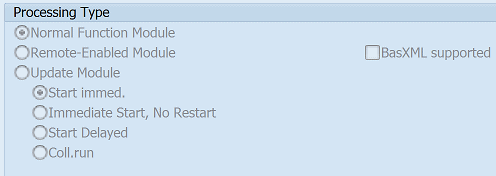SAP SUSR_ZBV_ADD_USERS_TO_SYSTEM Function Module for
SUSR_ZBV_ADD_USERS_TO_SYSTEM is a standard susr zbv add users to system SAP function module available within SAP R/3 or S/4 Hana systems, depending on your version and release level. It is used to perform a specific ABAP function and below is the pattern details, showing its interface including any import and export parameters, exceptions etc. there is also a full "cut and paste" ABAP pattern code example, along with implementation ABAP coding, documentation and contribution comments specific to this or related objects.
See here to view full function module documentation and code listing for susr zbv add users to system FM, simply by entering the name SUSR_ZBV_ADD_USERS_TO_SYSTEM into the relevant SAP transaction such as SE37 or SE38.
Function Group: SUU6
Program Name: SAPLSUU6
Main Program: SAPLSUU6
Appliation area: S
Release date: N/A
Mode(Normal, Remote etc): Normal Function Module
Update:

Function SUSR_ZBV_ADD_USERS_TO_SYSTEM pattern details
In-order to call this FM within your sap programs, simply using the below ABAP pattern details to trigger the function call...or see the full ABAP code listing at the end of this article. You can simply cut and paste this code into your ABAP progrom as it is, including variable declarations.CALL FUNCTION 'SUSR_ZBV_ADD_USERS_TO_SYSTEM'".
EXPORTING
NEW_SYSTEM = "
* INCL_PROFILES = ' ' "Customized ('C') or standard menu ('S') flag
* INCL_ACTGRPS = ' ' "Customized ('C') or standard menu ('S') flag
* REFERENCE_SYSTEM = "
* ALL_USERS = ' ' "Customized ('C') or standard menu ('S') flag
IMPORTING
ET_USER_ERROR_MESSAGES = "
TABLES
USERLIST = "
* USERPROFILES = "CUA: Assignment of Users to Local Profiles
* USERACTGRPS = "CUA: Assignment of Users to Roles
* RETLIST = "Return Parameters
* USERLAWS = "
IMPORTING Parameters details for SUSR_ZBV_ADD_USERS_TO_SYSTEM
NEW_SYSTEM -
Data type: USZBVLNDRC-RCVSYSTEMOptional: No
Call by Reference: No ( called with pass by value option)
INCL_PROFILES - Customized ('C') or standard menu ('S') flag
Data type: SMENSAPNEW-CUSTOMIZEDDefault: ' '
Optional: Yes
Call by Reference: No ( called with pass by value option)
INCL_ACTGRPS - Customized ('C') or standard menu ('S') flag
Data type: SMENSAPNEW-CUSTOMIZEDDefault: ' '
Optional: Yes
Call by Reference: No ( called with pass by value option)
REFERENCE_SYSTEM -
Data type: USZBVLNDRC-RCVSYSTEMOptional: Yes
Call by Reference: No ( called with pass by value option)
ALL_USERS - Customized ('C') or standard menu ('S') flag
Data type: SMENSAPNEW-CUSTOMIZEDDefault: ' '
Optional: Yes
Call by Reference: No ( called with pass by value option)
EXPORTING Parameters details for SUSR_ZBV_ADD_USERS_TO_SYSTEM
ET_USER_ERROR_MESSAGES -
Data type: IF_SUID_MSG_BUFFER=>TT_MESSAGESOptional: No
Call by Reference: Yes
TABLES Parameters details for SUSR_ZBV_ADD_USERS_TO_SYSTEM
USERLIST -
Data type: BAPIBNAMEOptional: No
Call by Reference: No ( called with pass by value option)
USERPROFILES - CUA: Assignment of Users to Local Profiles
Data type: USL04Optional: Yes
Call by Reference: Yes
USERACTGRPS - CUA: Assignment of Users to Roles
Data type: USLA04Optional: Yes
Call by Reference: Yes
RETLIST - Return Parameters
Data type: BAPIRET2Optional: Yes
Call by Reference: Yes
USERLAWS -
Data type: USR06SYSOptional: Yes
Call by Reference: Yes
Copy and paste ABAP code example for SUSR_ZBV_ADD_USERS_TO_SYSTEM Function Module
The ABAP code below is a full code listing to execute function module POPUP_TO_CONFIRM including all data declarations. The code uses the original data declarations rather than the latest in-line data DECLARATION SYNTAX but I have included an ABAP code snippet at the end to show how declarations would look using the newer method of declaring data variables on the fly. This will allow you to compare and fully understand the new inline method. Please note some of the newer syntax such as the @DATA is not available until a later 4.70 service pack (SP8), which i why i have stuck to the origianl for this example.| DATA: | ||||
| lt_userlist | TYPE STANDARD TABLE OF BAPIBNAME, " | |||
| lv_new_system | TYPE USZBVLNDRC-RCVSYSTEM, " | |||
| lv_et_user_error_messages | TYPE IF_SUID_MSG_BUFFER=>TT_MESSAGES, " | |||
| lt_userprofiles | TYPE STANDARD TABLE OF USL04, " | |||
| lv_incl_profiles | TYPE SMENSAPNEW-CUSTOMIZED, " ' ' | |||
| lt_useractgrps | TYPE STANDARD TABLE OF USLA04, " | |||
| lv_incl_actgrps | TYPE SMENSAPNEW-CUSTOMIZED, " ' ' | |||
| lt_retlist | TYPE STANDARD TABLE OF BAPIRET2, " | |||
| lv_reference_system | TYPE USZBVLNDRC-RCVSYSTEM, " | |||
| lt_userlaws | TYPE STANDARD TABLE OF USR06SYS, " | |||
| lv_all_users | TYPE SMENSAPNEW-CUSTOMIZED. " ' ' |
| CALL FUNCTION 'SUSR_ZBV_ADD_USERS_TO_SYSTEM' " |
| EXPORTING | ||
| NEW_SYSTEM | = lv_new_system | |
| INCL_PROFILES | = lv_incl_profiles | |
| INCL_ACTGRPS | = lv_incl_actgrps | |
| REFERENCE_SYSTEM | = lv_reference_system | |
| ALL_USERS | = lv_all_users | |
| IMPORTING | ||
| ET_USER_ERROR_MESSAGES | = lv_et_user_error_messages | |
| TABLES | ||
| USERLIST | = lt_userlist | |
| USERPROFILES | = lt_userprofiles | |
| USERACTGRPS | = lt_useractgrps | |
| RETLIST | = lt_retlist | |
| USERLAWS | = lt_userlaws | |
| . " SUSR_ZBV_ADD_USERS_TO_SYSTEM | ||
ABAP code using 7.40 inline data declarations to call FM SUSR_ZBV_ADD_USERS_TO_SYSTEM
The below ABAP code uses the newer in-line data declarations. This allows you to see the coding differences/benefits of the later inline syntax. Please note some of the newer syntax below, such as the @DATA is not available until 4.70 EHP 8.| "SELECT single RCVSYSTEM FROM USZBVLNDRC INTO @DATA(ld_new_system). | ||||
| "SELECT single CUSTOMIZED FROM SMENSAPNEW INTO @DATA(ld_incl_profiles). | ||||
| DATA(ld_incl_profiles) | = ' '. | |||
| "SELECT single CUSTOMIZED FROM SMENSAPNEW INTO @DATA(ld_incl_actgrps). | ||||
| DATA(ld_incl_actgrps) | = ' '. | |||
| "SELECT single RCVSYSTEM FROM USZBVLNDRC INTO @DATA(ld_reference_system). | ||||
| "SELECT single CUSTOMIZED FROM SMENSAPNEW INTO @DATA(ld_all_users). | ||||
| DATA(ld_all_users) | = ' '. | |||
Search for further information about these or an SAP related objects